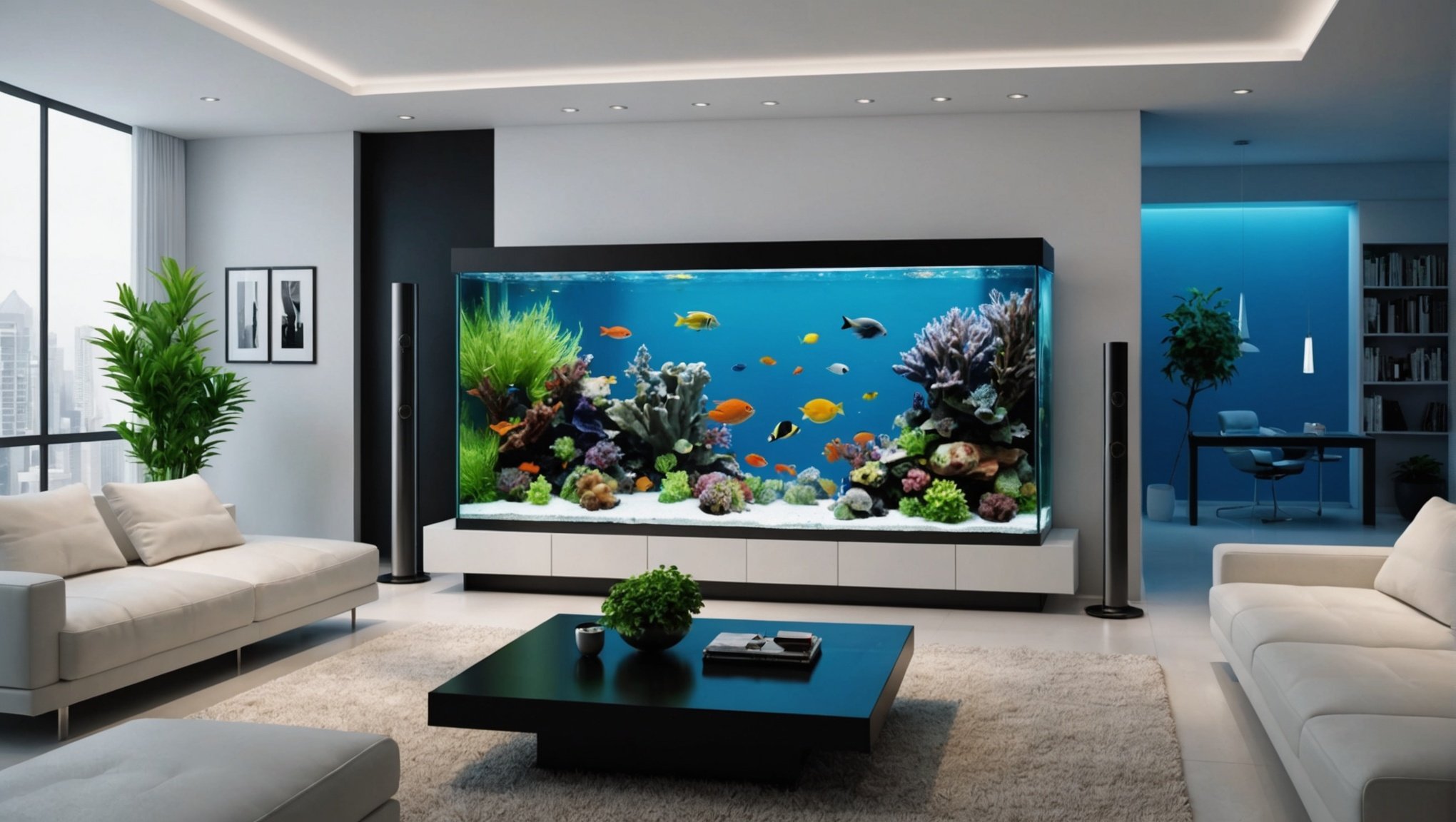Understanding Minimalist Aesthetics
Minimalist design is characterised by its focus on simplicity and functionality, stripping down structures to their essentials for a clean and uncluttered appearance. By implementing these principles, modern decor embraces open spaces and elements that serve practical purposes, reducing any visual noise that might clutter a room.
The emphasis in minimalist design lies on using fewer items to create a sense of spaciousness and calm. This is highly beneficial in living room aesthetics, where reducing distractions can enhance relaxation and foster an environment of peace.
In the same genre : Top Pest-Repelling Plants for a Thriving Home Vegetable Garden
Colour schemes play a pivotal role in minimalist aesthetics. Neutral tones such as whites, greys, and beiges are often favoured to maintain a serene and understated look. However, incorporating textures can add depth without disturbing the minimalist appeal. For instance, materials like wood or stone can introduce richness while maintaining the design’s simplicity.
Functionality extends to furniture selection, where multifunctional pieces are preferred to maximize space efficiently. A minimalist living room must balance maintaining a modern decor style while serving the practical needs of everyday life.
Also read : Essential Smart Home Features for a Tech-Savvy and Elderly-Friendly Living Space
Choosing the Right Aquarium Style
When selecting an aquarium style, consider how it fits with your minimalist decor. Explore various modern aquariums to find the one that aligns with your taste. Sleek designs include frameless features and clear lines, providing unobstructed views of your aquatic life.
Glass vs. Acrylic Aquariums
Glass tanks are popular for their clarity and scratch resistance. However, they can be heavier and more fragile than acrylic options. Acrylic aquariums offer lightweight and impact-resistant qualities, making them ideal if mobility or durability is a priority. Although they may scratch more easily, their curved edges and seamless designs often appeal to those seeking elegance.
Factors in Selecting an Aquarium
In choosing the perfect aquarium, consider its integration with your existing design elements. The tank’s size and shape should complement, not clutter, your home’s aesthetics. Ensure it provides adequate volume for the planned aquatic environment. Aquarium styles like nanos bring compact beauty to small spaces, while extensive setups can serve as a stunning focal point. Sleek designs with built-in filtration systems can enhance the overall minimalist experience, reducing the need for external equipment. Each choice shapes not only the look but the function of your aquatic setting.
Designing the Aquarium Setup
Establishing an aquarium in your living space involves careful interior design and strategic space utilization.
Placement within the Living Room
Determining the ideal placement of an aquarium within your living room is crucial. A well-positioned aquarium enhances the room’s flow rather than disrupts it. Place it where it becomes a natural focal point without hindering movement. Consider areas away from direct sunlight to prevent algae growth, which can complicate maintenance.
Scale and Size Considerations
When it comes to selecting the scale and size, it’s essential to match the aquarium’s dimensions with the room’s scale. A compact room may be overwhelmed by an enormous tank. Conversely, a tiny aquarium may feel insignificant in a spacious area. Strive for a balanced appearance to avoid visual clutter or dwarfing other elements in your room.
Incorporating Plants and Decorations
Choosing the right aquatic plants and decorations can harmonize your aquarium setup with a minimalist aesthetic. Select low-maintenance plants like Java Fern or Anubias and complement them with subtle substrates and pebbles. Introducing these elements ensures a lush yet refined underwater landscape, enhancing the overall appeal of your living space without overpowering it.
Selecting Complementary Furnishings
Selecting complementary furniture when incorporating an aquarium into your space can significantly enhance the overall aesthetic. Starting with ideal furnishing choices, consider pieces that accentuate your aquarium instead of overshadowing it. Transparent or minimalist furnishings can allow the aquarium to be the focal point, while still maintaining a cohesive look. Decor pairing becomes essential, as items such as simple, sleek chairs or tables in neutral tones work well to highlight the vibrant life within the aquarium.
Achieving visual harmony involves balancing furniture around the aquarium. Place furnishings symmetrically, or in a way that frames the aquarium, ensuring minimalist furnishings draw attention to the aquatic centrepiece. This balance prevents the area from becoming too busy and helps maintain a clean, inviting atmosphere.
Certain decor styles work wonderfully alongside aquariums. For instance, a modern minimalist style often pairs well—think uncluttered surfaces and strategic use of complementary furniture like glass or light wooden tables. Another excellent option could be a nature-inspired decor, which marries the theme of the aquarium with materials like natural wood and soft earthy hues. By selecting the right furnishings and decor styles, the aquarium can seamlessly become an integral part of the room’s overall design.
Color Schemes and Lighting
Creating a harmonious aquarium space involves thoughtful consideration of color coordination and lighting choices. By selecting an effective color palette, you can achieve a cohesive look that enhances the visual appeal of your aquarium. Begin by choosing colors that complement each other, considering both the tank’s contents and your surrounding décor. This ensures a balanced ambiance creation.
The role of lighting cannot be overstated when it comes to showcasing your aquarium. Both natural and artificial lighting play crucial parts in highlighting the vibrant colors and natural behaviors of aquatic life. Natural light, when used effectively, can beautifully illuminate your aquarium. However, it’s important to strike a balance to avoid harmful effects such as algae growth.
To maximize the benefits of natural light without endangering your aquatic environment, consider indirect sunlight exposure during cooler parts of the day. In contrast, artificial aquarium lighting offers a controlled environment, allowing you to fine-tune the light spectrum and intensity. This not only enhances the aquarium’s aesthetics but also supports the health of aquatic plants and animals.
In summary, meticulously planned color coordination and balanced lighting create an inviting and healthy aquatic environment.
Practical Installation Tips
When installing an aquarium in your living room, start by selecting a stable, level surface near a power outlet. A stand specifically designed for the aquarium size can prevent accidents. Ensure the surface can support the weight, which includes water, decor, and the tank itself.
Step-by-Step Installation Guide
- Position the Aquarium Safely: Leave space for easy access to maintenance areas.
- Install Filtration and Heating: Follow manufacturer guidelines to ensure optimal positioning and operation.
- Add Natural Substrate and Decor: Include elements like rocks or plants, ensuring they are secured to avoid floating.
Maintenance Routines
Adopt minimalist principles for upkeep by scheduling regular tasks. Routine water changes, filter checks, and algae removal should be managed bi-weekly to prevent build-up and maintain clarity without hassle. Consistency is key to sustaining a healthy tank environment.
Suggested Tools and Accessories
To avoid clutter, use:
- Magnetic Algae Cleaners: For efficient interior glass cleaning without getting hands wet.
- Auto-feeders: Maintain feeding schedules with ease, crucial when adhering to minimal maintenance.
- Gravel Vacuum: Assist in effortless cleaning of the substrate without disturbing the décor.
Practical aquarium installation and maintenance need not be overwhelming, staying streamlined and effective with the right approach and tools.
Visual Inspiration and Examples
Exploring real-life setups allows aspiring aquarists to envision transformative potential within their own spaces. Various design examples illustrate how minimalist aquarium setups can enhance a room’s ambience. These setups often merge functionality with art, providing a tranquil focal point in otherwise bustling environments.
Consider a living room where a sleek, transparent tank adopts a natural aquascape, reflecting light and expanding the perception of space. In another example, a kitchen, traditionally overlooked for such installations, can integrate a vertical aquarium, creating a refreshing culinary workspace. Each aquarium becomes more than just a home for aquatic life; it is a conversation piece that shapes the room’s overall mood.
For those seeking aquarium inspiration, numerous sources cater to different tastes and constraints. Platforms such as Instagram and Pinterest teem with stunning visuals—each unique aquarium offering insights into potential designs. Additionally, design blogs delve into aquascaping techniques and trends, offering a more comprehensive understanding of integrating minimalistic designs into everyday spaces.
Consequently, using diverse design inspirations and examples profoundly impacts how one approaches aquarium setups. These examples show that aquariums do not merely complement living spaces; they redefine and elevate them.











